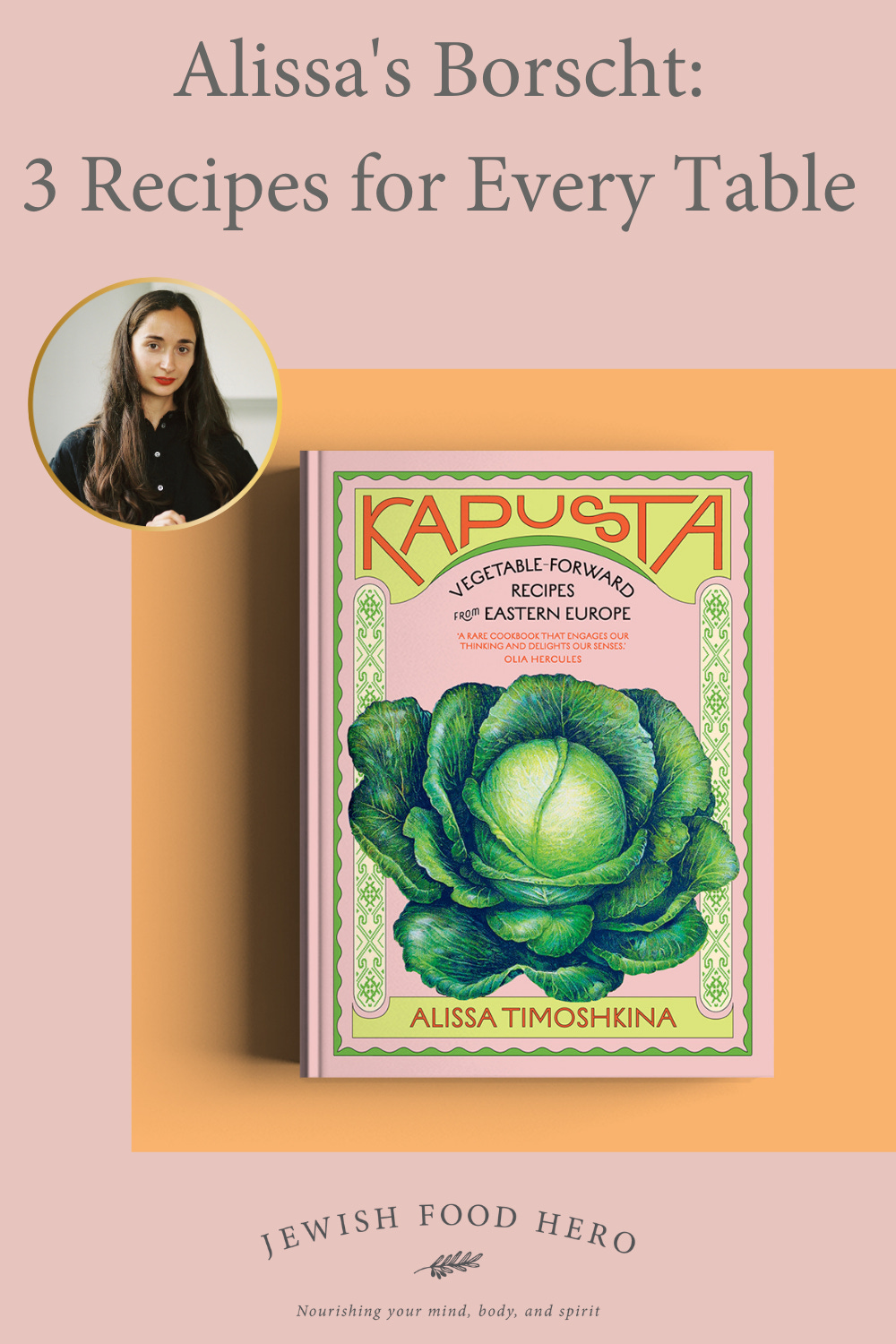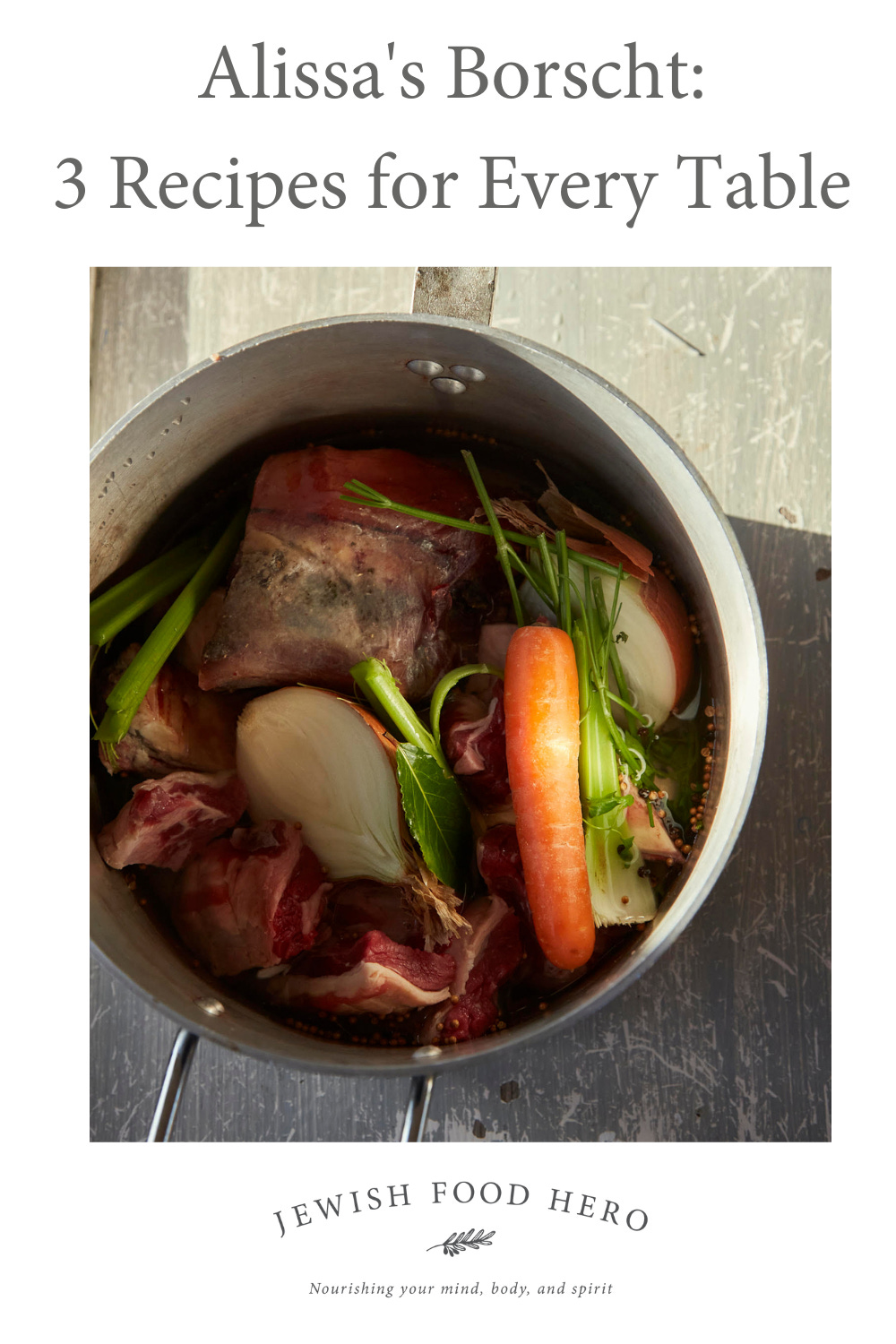Alissa's Borscht: 3 Recipes for Every Table
Kapusta: Vegetable-Forward Recipes from Eastern Europe
Let’s get right to it! In this post, you'll discover four things:
A classic beef borsch, rich and deeply flavored with tender meat and root vegetables.
A hearty vegan borsch with mushrooms and prunes, bringing an earthy, sweet, and tangy twist.
A refreshing chilled beet soup (Chłodnik), a creamy and vibrant summer favorite.
A look inside Kapusta: Vegetable-Forward Recipes from Eastern Europe, a cookbook celebrating the humble vegetables that define the region’s cuisine.
These three Borsch recipes are contributed by Alissa Timoshkina, a food writer, historian, and cookbook author with a deep passion for Eastern European food culture. Born in Siberia with Ukrainian-Jewish heritage, she blends history and culinary traditions in her work. She is also the co-founder of #CookForUkraine, a global initiative raising funds and awareness for Ukraine through food. Her writing and recipes have been featured in The Guardian, The Independent, British Vogue, and more.
Is Borscht a Jewish Food?
Borscht is deeply rooted in Eastern European cuisine, especially in Ukraine, Russia, and Poland. While not exclusively Jewish, it became a staple of Ashkenazi Jewish cooking, particularly among Eastern European Jewish communities. Jewish variations include:
Meat-based borscht, often served on Shabbat.
Dairy-based chilled borscht (Chłodnik) with sour cream or kefir.
Parve (vegan) borscht, popular in Jewish households that kept kosher.
Borscht is a beloved, comforting dish in both Israel and America, particularly among the Ashkenazi Jewish community, and is enjoyed year-round for its versatility and rich flavor.
Introduce Yourself to Our Readers
Could you share a bit about your personal story? What drew you to food and storytelling, and how has your own heritage, upbringing, or life experiences influenced your approach to cooking and writing?
I was born in Siberia into a family of mixed Eastern European heritage. I have Ukrainian Ashkenazi lineage on my mom’s side, and it’s that side of my family that had the greatest influence on my life. For the first 10 years of my life, we lived together with my great-grandmother, Rosalia, who was a Holocaust survivor, and her stories have always fascinated me. Her cooking was there every day, and the earliest food memories I have are all connected to her dishes: borscht, varenyky dumplings with mashed potatoes and caramelized onions, poppy seed rolls, and chocolate rugelach.
My entire adult life, I have been finding creative ways to engage with and make sense of my family’s Jewish lineage and the history of Ashkenazi Jews in general. Before I went into food, I worked in academia, earning a PhD in Holocaust and Soviet cultural history. Food became another means of delving into the topic, and my food writing focuses on the women in my family, family histories, and Jewish culinary culture.
What Inspired You to Write Kapusta?
What sparked the idea for Kapusta? What led you to explore and celebrate Eastern European cuisine in your work?
Kapusta came out of the profound pain of Russia’s invasion of Ukraine in February 2022 and my work as co-founder of the Cook for Ukraine fundraising campaign. Through CfU, I’ve met so many wonderful people sharing Ukrainian and Eastern European recipes, who inspired me to delve deeper into the cuisine of the region and my own family heritage.
It has also shown me how little is still known about the cuisine of Eastern Europe in the West (very generally speaking), so I felt it was time to write a book that would introduce people to the region by looking at the most humble and accessible ingredients, like cabbage and beetroot. These ingredients are full of powerful flavors and tell fascinating stories about Eastern European food culture and history.
Jewish Ashkenazi Cuisine in Eastern Europe
Jewish Ashkenazi cuisine is deeply rooted in Eastern European culinary traditions. How does your cookbook explore or intersect with the food and traditions of the Jewish communities from this region, and what role do these dishes play in the broader narrative of Eastern European food?
My book focuses a lot on Ashkenazi cooking, even though I tried to keep my focus balanced and shed light on other diasporic cuisines of the region, like those of the Roma and the Tatars. But given my personal connection to Ashkenazi food, it is definitely a theme that runs throughout the book.
It really is a fascinating and important relationship. I see Ashkenazi Jews as culinary and cultural cross-pollinators who have contributed immensely to the wider story of Eastern European cuisine due to their history of migration, travel, and forced displacement. We see it in the dishes that arrived with them in Eastern Europe from Italy or Germany, as well as in the many dishes that have become globally known thanks to the migration of Ashkenazi Jews to the United States—making borscht, knishes, bagels, and dumplings iconic.
The Story Behind Your Borscht Recipe
Borscht is such an iconic dish with deep cultural and historical roots in Eastern Europe. Could you share the story behind your borscht recipe in Kapusta? What inspired your approach to creating both the vegan and beef versions, and what does this dish mean to you personally?
I tried to offer a balance between anthropological and personal insight into these recipes, showcasing a wide range of variations. Borscht is truly one of the most iconic soups of Eastern Europe, and there are almost innumerable ways of preparing it. I wanted to stay true to more traditional recipes (I have a very unorthodox version in my first cookbook) and show how deeply seasonal this soup can be. The meat version is a perfect winter warmer, while the mushroom and cold soup versions are best suited for warmer days.
To me, borscht is everything! It’s a symbol of home, comfort, the women in my family, and my own journey into womanhood and motherhood. It is by far my favorite soup, and every time I cook and eat it, I have profound experiences: I remember myself as a child eating my granny’s soup, and I delight in the sight of my little daughter eating my soup. In moments like these, I feel nourished on every level—from my body to my spirit.
Classic Beef Borscht
Serves 6
For the Stock:
500g stewing beef (add beef bones if available)
2 bay leaves
1 tsp black peppercorns
1 tsp coriander seeds
1 tsp fennel seeds
1 tbsp fine sea salt
A handful of parsley or dill stalks (if you have any leftover)
1 onion, washed, skin on, cut in half
1 carrot, scrubbed, skin on
2 celery sticks
For the Soup:
1 medium onion, diced
1 large carrot, peeled and grated
2 large or 4 medium beetroots, peeled and grated
4 tbsp tomato purée
1 tbsp brown sugar
1 red bell pepper, thinly sliced
½ medium white cabbage, thinly sliced
1 tin red kidney beans, drained and rinsed
2 cloves garlic, finely crushed
1 tbsp apple cider vinegar or sauerkraut brine
1 large bunch fresh dill, chopped
Salt and black pepper, to taste
To Serve:
1 tbsp sour cream per bowl
1 tbsp freshly chopped dill
1 slice toasted rye bread, rubbed with fresh garlic
Extra sea salt flakes
Method:
Make the Stock:
Place all stock ingredients into a large pot and cover with 3 liters of water.
Bring to a boil, then reduce the heat and simmer for 2 hours, skimming off any froth.
If the liquid evaporates too quickly, add more water and adjust the salt as needed.
Strain through a sieve, discarding the vegetables, bay leaves, and spices.
Rinse the beef chunks to remove excess froth. Some coriander and fennel seeds will remain, adding to the flavor.
Prepare the Soup:
In a large frying pan, heat some sunflower oil.
Sauté the diced onion with the grated carrot and beetroot, adding a pinch of salt. Cook over medium heat for 15–20 minutes until soft. If the mixture starts to stick, add a ladle of broth.
Stir in the tomato purée and brown sugar. Cook for another 8–10 minutes.
Combine and Cook:
Return the strained stock to the pot.
Add the sautéed vegetables, rinsing the pan with stock to capture all flavors.
Stir in the cabbage, kidney beans, crushed garlic, and apple cider vinegar.
Simmer over medium heat for 15–20 minutes.
Towards the end of cooking, add the chopped dill and adjust seasoning.
Let the soup rest, covered, for 40 minutes if possible.
Serve:
Ladle into bowls and top with sour cream, fresh dill, and black pepper.
Serve with toasted rye bread rubbed with garlic.
Vegan Borscht with Mushrooms & Prunes
Serves 6
Ingredients:
30g wild mushrooms
1 onion, peeled and diced
1 carrot, peeled and grated
2 small or medium beetroots, peeled and grated
1 tsp dried dill
2 large potatoes, peeled and cubed
⅓ medium white cabbage (200–300g), shredded
1 tin red kidney beans, drained and rinsed
2 cloves garlic, finely grated
70g prunes, roughly chopped
1 tbsp allspice berries
2 bay leaves
2 liters vegetable stock
100ml sauerkraut with plenty of brine (or substitute apple cider vinegar, using half the amount)
A handful of fresh dill
Sour cream, to serve (optional)
Method:
Prepare the Mushrooms:
Soak the wild mushrooms in 500ml of hot water and set aside.
Cook the Base:
Heat oil in a large pot.
Sauté the onion for 8 minutes, then add the carrot and beetroot with a pinch of salt. Cook for another 10 minutes.
Add the Broth & Vegetables:
Strain the mushrooms, reserving the soaking liquid. Chop the mushrooms and add them to the pot.
Pour in 2 liters of vegetable stock, the reserved mushroom liquid, allspice berries, and bay leaves.
Bring to a boil, then add the potatoes, cabbage, kidney beans, garlic, and prunes.
Simmer for 45 minutes.
Finish & Rest:
Stir in the sauerkraut (or vinegar, if using).
Remove from heat and let cool completely. Refrigerate overnight for best flavor.
Serve:
Reheat gently, remove the floating allspice berries, and ladle into bowls.
Garnish with fresh dill and, if desired, sour cream.
Chłodnik: Cold Borscht with Kefir
Serves 4
For the Broth:
3 large beetroots, peeled and halved
3 garlic cloves, crushed
1 onion, peeled and halved
1 carrot, scrubbed and cut into chunks
1 tsp allspice berries
1 tbsp salt
1 tbsp apple cider vinegar or 4 tbsp fermented beetroot brine
1.5 liters water
For the Topping:
1 medium cucumber, peeled and diced
4 radishes, diced
8 tbsp mixed fresh herbs (dill, parsley, chives)
2 tbsp kefir per plate
Horseradish cream (optional, for serving)
Method:
Make the Broth:
Place all broth ingredients (except vinegar or brine) into a pot with salted water.
Bring to a boil, then simmer over medium heat for 40 minutes to 1 hour.
Remove from heat and let cool at room temperature, then refrigerate for a few hours.
Strain & Adjust Flavor:
Strain the broth through a fine sieve or muslin cloth. Discard all vegetables except the beetroot.
Finely dice the cooked beetroot and set aside.
Stir in vinegar or fermented beetroot brine. The broth should be sweet, earthy, and tangy. Adjust seasoning as needed.
Assemble & Serve:
Ladle the chilled soup into bowls.
Swirl kefir through the broth and top with diced cucumber, radishes, and fresh herbs.
Serve with horseradish cream on the side, if desired.
A big thank you to Alissa for sharing her recipes and new cookbook with us.
I hope you find your forever borscht recipe among these three delicious variations. Thanks for reading
To our health and inspiration
Kenden













Who knew there are multiple borschts? I grew up watching my father enjoy cold borscht with beets (& sour cream of course). These look great & healthier! ~Joan